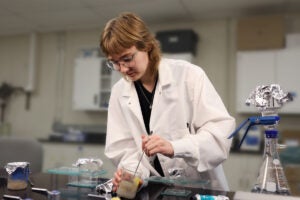A hair strand-thin worm is providing substantial clues on how nerves regenerate, offering insight and hope to finding genes that affect nerve generation and ultimately new drugs and therapies for human neurodegenerative diseases such as Parkinson’s or Alzheimer’s.
Researchers at The University of Texas at Austin, with collaborators from the University of Michigan, discovered that during surgery to sever its nerves, the 1 millimeter-long worm (called C. elegans) regenerated nerves up to 12 times faster without the use of anesthetics.
“There was this interesting phenomenon,” said Adela Ben-Yakar, assistant professor in mechanical engineering. “Without using anesthetics, the axon (which conducts electrical impulses from the neuron) regrew much faster. So we realized the anesthetics really did interfere with the regeneration process.”
She noted that the axons regrew within 60 to 90 minutes without the use of anesthetics. Previously with the use of anesthetics, axons took as long as six to 12 hours to regrow. To study nerve regeneration, the axons, which connect neurons, were severed using ultra-short laser pulses to observe what promoted their regrowth.
Researchers observed this critical occurrence as they performed breakthrough, laser nanosurgery using a specially designed micro-fluidic microchip. The chip painlessly immobilizes the live worm using pressure from fluid within the chip and acts as both a tiny operating table and recovery room to examine the worm, which has been widely studied and has more in common with humans than one might think.
Their findings were published in the May issue of Nature Methods.
These results are a continuation of Ben-Yakar’s work, which in 2004 showed for the first time certain axons in the roundworm could regenerate when severed or snipped using femtosecond (one millionth of a billionth of a second) laser pulses and was featured in Nature.
Previously, researchers had to anesthetize the worm, perform the surgery and place it in a recovery area. Then, they had to anesthetize it again to study the worm post-surgery. With the new micro-fluidic device and its recovery chambers Ben-Yakar said performing surgeries on the worms is faster, thus, speeding up the research process.
“It’s now the best way in a living animal to provide information quickly,” she said.
Ben-Yakar said the invention of the micro-fluidic device has far-reaching applications because it allows for faster genetic and pharmacological screenings, accelerating the discovery of new genes that affect nerve regeneration and new drugs and therapies. She said each surgery and imaging session took just 1/20th of the time it took previously thanks to the new chip, which allows for quick funneling from the surgery table to the recovery area and eliminates the need for anesthetics.
The paper’s co-authors include: Samuel X. Guo, Frederic Bourgeois and Nicholas J. Durr of the Department of Mechanical Engineering at The University of Texas at Austin; and Trushal Chokshi and Nikos Chronis of the University of Michigan.
Photos of Ben-Yakar are available online.




